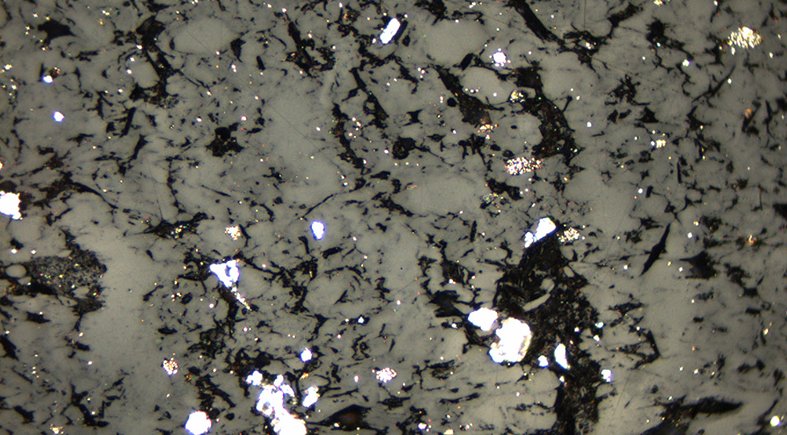Has there ever been life on Mars? And if so, what is left of it? Answers to these questions could be found in a particular rock formation called 'alum shale', which is found in Scandinavia. An international team of researchers from China, Denmark and Australia as well as the GFZ German Research Centre for Geosciences has compared what remains when material from special horizons in the alum shale on the one hand and Martian rock on the other is "burned", or more precisely: subjected to so-called pyrolysis in an inert atmosphere. The results are very similar, the researchers write in the journal Geology.
Kolm is the name given to rock lenses of different sizes, which are very rich in organic material. They are found in the alum shale in Scandinavia, which is about half a billion years old. The special feature: The clay rock contains very high proportions of uranium. At the time of deposition about half a billion years ago, algae and other microorganisms lived in shallow waters. The dead material was only covered by thin sediments and was transformed into rock over millions of years. In tectonically active areas at higher temperatures, the organic carbon was altered to crude oil and natural gas, whereas on the Baltic Shield, with only low subsidence rates, the dark uranium-bearing rock lenses called Kolm formed. The oil industry uses the presence of uranium to find clues to oil or gas-producing formations. Geologists, however, realized that radiation also triggers other processes. The bombardment by high-energy particles from the uranium decay changes the fossilized organic material in the Kolm.
Today's Mars has hardly any atmosphere and no magnetic field that would protect it from radiation from space. Therefore, its surface is also exposed to constant bombardment by cosmic radiation. If life had ever existed there, the organic molecules would have been destroyed long ago. But what if there were microorganisms on Mars similar to those on Earth half a billion years ago, which lived in shallow waters, died and petrified? The starting point would be the same as with Kolm on Earth, the radiation lasting millions of years would also be similar.
From studies of the Martian rock we know of conditions there that led to sedimentary rocks, i.e. water bodies, weathering, erosion and deposition. The U.S. Mars rover 'Curiosity' has pyrolysed rocks from the Mars surface. The resulting hydrocarbons are very similar in composition to the hydrocarbons produced by the pyrolysis of Kolm. The researchers are cautious in their interpretation: "Our results support the idea that the organic molecules detected in the Martian rock could be the remains of life from shallow waters," says Hans-Martin Schulz from GFZ, "Deeper below the Martian surface, more pristine material could be found that has not yet been altered as much by the radiation."
Original study: Yang, S., Schulz, H.M., Horsfield, B., Schovsbo, N.H., Grice, K., Zhang, J., 2020: Geological alteration of organic macromolecules by irradiation: Implications on organic matter occurrence on Mars. Geology. DOI: 10.1130/G47171.1
Scientific contact:
Dr. Hans-Martin Schulz
Phone: +49 (0)331 288 1789
hans-martin.schulz@gfz-potsdam.de
Media contact:
Josef Zens
Head of Public and Media Relations
Phone: +49 331 288-1040
Josef.Zens@gfz-potsdam.de
Twitter: @GFZ_Potsdam









![[Translate to English:] Torsten Sachs in front of a climate station on a field](/fileadmin/_processed_/3/9/csm__TorstenSachs_bearbeitet_GS_4a1365ef84.jpeg)

![[Translate to English:] left image flood at the Ahrtal: image from above, several houses are flooded; left image:: Heidi Kreibich;](/fileadmin/_processed_/4/4/csm_Bild2_9af0130e9f.png)



![[Translate to English:] Start der Vega Rakete](/fileadmin/_processed_/6/4/csm_20231201-kachel_Vega-VV23-launch_ESA-CNES-Arianespace_706716b68c.jpeg)









![[Translate to English:] Poster exhibition at the Brandenburg Hydrogen Day at the GFZ, some participants in the foreground](/fileadmin/_processed_/6/5/csm_Erster_Brandenburgischer_Wasserstofftag_GFZ_402fcec95e.jpeg)
![[Translate to English:] Group picture of the participants](/fileadmin/_processed_/9/4/csm_20231108_CAWa-Workshop-Tashkent_Gruppenbild_99ea779d8a.jpeg)

![[Translate to English:] [Translate to English:] Hörsaal](/fileadmin/_processed_/e/6/csm_H%C3%B6rsal_e21ac645fb.jpeg)


![[Translate to English:] The Delegations in the Historic Library on the Telegrafenberg. In the back there are from left to right, the Dutch Ambassador for Germany, Ronald van Roeden, the Dutch Minister for Education, Culture and Science, Robbert Dijkgraaf and the scientific director of the GFZ, Susanne Buiter.](/fileadmin/_processed_/d/b/csm_Kachel-2_9eba4b4212.jpeg)

